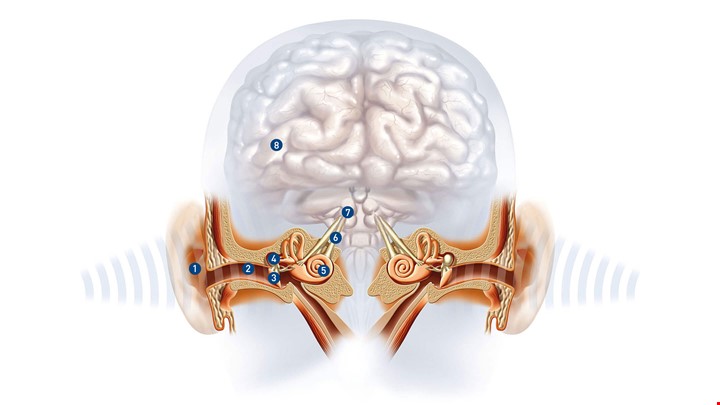Function of the ear
To understand how our hearing works we start a “virtual” tour through our ear
The ear - structure and function
The rustling of leaves in the wind, the singing of cicadas, the quiet passage of a classical piece of music: a healthy ear can perceive the finest nuances due to its structure and function - and distinguish important from unimportant sound signals. In the following you will learn how our hearing functions.

The ear - How hearing and sound processing
work
When we speak about the ear we normally mean the auricle, the part of the ear we can see. But the ear is much more than that, and it is precisely the other part which makes the wonder of hearing possible.
The sound first passes through the auditory canal of the outer ear, then the middle ear. The inner ear with the auditory nerve then converts the alternating pressure into electrical nerve impulses. Via the auditory nerve, the sound information thus processed reaches the auditory centre of the brain, where it is decoded.
During the hearing process, sound processing takes place which differentiates between important and unimportant sound signals. Important signals include, for example, the voice of a familiar person, a certain type of music or an announcement on a train platform. They are also called useful sound.
On the other hand, there are the unimportant or even disturbing noises such as machine noise, the traffic and babble of voices.
The healthy ear is able to pass on the sound in such a way that the useful sound can be filtered out in the brain. Our hearing therefore functions selectively.
The auditory components: The ear and its structure and function
(1) The outer ear consists of the auricle and the auditory canal, which is up to about 3.5 centimetres long. The sound waves from the environment that reach the outer ear in the form of air movements are bundled and transmitted through the auditory canal. The shape of the auricle supports the ability of the ear to locate sound sources.
(2) These vibrations are carried through the auditory canal to the eardrum.
(3) The eardrum then passes the vibrations on to the middle ear.
(4) The middle ear is a cavity also known as the "tympanic cavity". It is filled with air that enters from the nasopharynx via the so-called Eustachian tube. The smallest bones in the body (malleus, incus and stapes which combine to form the ossicular chain) can be found there. These bones convert the vibrations in the air into liquid movement which then reach the inner ear.
(5) In the inner ear, the cochlea, the liquid causes the basilar membrane to vibrate. This is where the actual spiral organ (of Corti) is located. Electric impulses are created in its approximately 20,000 hearing cells.
(6) The acoustic nerve receives the impulses and passes them to the brain stem.
(7) In the brain stem they are allocated to the appropriate “processing centre” in the brain. Here the signals from both ears are processed together.
(8) The brain’s “processing centres” link the incoming impulses of acoustic frequencies with the relevant information, and we understand what we have just heard.
Discover other articles
- Smart Hearing: What intelligent hearing systems do
- The sooner an ENT specialist is consulted, the better
- Comfort to go: KINDvitalo
- Hearing loss and its causes
- Hearing aids while driving
- Optimized design for hearing solutions
- Meniere's disease
- Hearing test: Procedure and result
- Loud alone is not enough:
- Noise protection for the ears